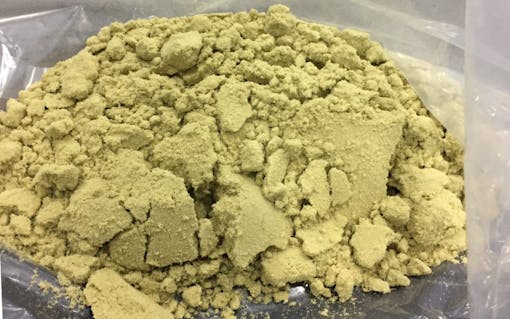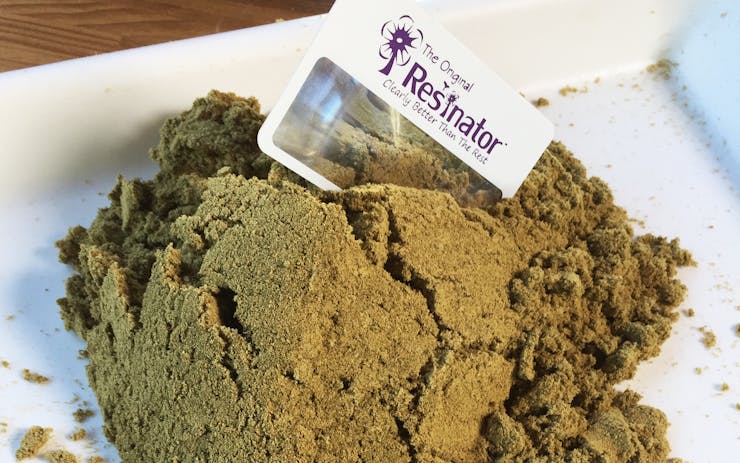In this four-part series, The Original Resinator and four partners discuss the equipment, support, and methods they use to produce pure and potent cannabis concentrates and extracts. Part 1 is sponsored by The Original Resinator, the largest capacity multi-use botanical extraction unit on the market, and Support the Roots, makers of the Sasquash Rosin Press.
For many cannabis users, concentrates like budder and shatter are a delicacy—something to be enjoyed on special occasions, and savored like a good meal. And just as with any good meal, ingredients matter, and you won’t find ingredients much finer than live resin, extracted directly from freshly harvested cannabis.

A batch of dry sift kief from a Resinator. (Courtesy of The Original Resinator)
The Original Resinator’s innovative freeze, fracture, and extraction process uses high-quality micron screens, powerful custom motors, and liquid CO2 to lower temperatures well below freezing, allowing users to harvest trichome-rich live resin quickly, efficiently, and without the use of solvents that many consumers aim to avoid. Sub-zero temperatures are great for any extraction, but especially helpful for extracting from live or uncured cannabis, where CBD and THC-A are at their highest levels. Frozen trichomes instantly fracture and then fall through the micron screen, so that you get the good stuff and leave the rest behind.
With The Original Resinator, pulling a big batch of dry sift kief from some killer flower is satisfying in the extreme—but it’s not the end of the road by a long shot. You can send that material for a second spin, this time with the addition of water and ice for a “bubble while you tumble” experience. Filter the resulting water through a series of micron-sifting bags and you’ll separate the liquid and plant material from the resin, coming away with potent, resinous bubble hash or live ice resin.
The Original Resinator can extract both of these concentrates from up to 15 pounds of flower or sugarleaf in as little as 20 minutes from setup to teardown, without using any harsh chemical solvents—just the power of physics.
Those beautiful batches of pure, clean kief and bubble hash are sights to behold; but they’re also ingredients in their own right. Like turning coal into diamonds, the right amount of heat and pressure applied with a rosin press can bring out the best in these concentrates—literally.
“Hash rosin and sift rosin is the most exciting way to make rosin. When you press hash and sift rosin properly, a river of oil comes pouring out that smells and tastes just amazing,” says Matt Ilich, president of Support the Roots, which manufactures the Sasquash Rosin Press.

Under pressure, live resin gets transformed into concentrate. (Courtesy of Support the Roots)
While a big batch of sift is impressive to behold, you’re going to need some serious machinery to unlock its full potential by crushing out the oils as delicious, dabbable concentrates. That’s where the Sasquash comes in. Fabricated in California, these presses use precision-machined steel plates to apply heat and pressure—up to 20,000 pounds of it—to material, squeezing the good stuff out of flower, kief, and hash alike. They also come in a variety of sizes suitable to a wide variety of applications.
“Our plate sizing is designed around commercial and manufacturing use,” says Ilich. “That means you can process a lot of product at once, while also carefully controlling the pressure, temperature, and plate speed—all essential factors in getting a good squish from dry sift or hash.”
What kind of extract you end up with depends on how you treat your hash or sift during a press. Low temperature presses will take longer to melt the trichomes, resulting in an extract like budder or crumble. Higher temperature operations melt material more quickly, producing more stable extracts like shatter. And keep in mind—temperatures are all relative, and materials like sift and hash should be pressed at lower temperatures than flower, between 150 and 210 degrees Fahrenheit.

Post-press extract from a Sasquash Rosin Press. (Courtesy of Support the Roots)
Whatever temperature you’re pressing at, though, you’ll want to apply pressure nice and slowly to avoid blowing out the bags that enclose hash and sift during a press extraction. Nothing can spoil a batch of budder or shatter faster than exploding a bag into it.
If you’re looking to get those stunning streams of amber oil running strong from the Sasquash, though, you need to start with the cleanest sift or hash available.
“The yield you get from sift or hash all depends on the purity of what you’re putting in. The less plant material, the more of a yield you’re going to get,” says Ilich. “The Resinator is a great product to make really pure sift from, so it goes hand in hand with a rosin press like the Sasquash.”






